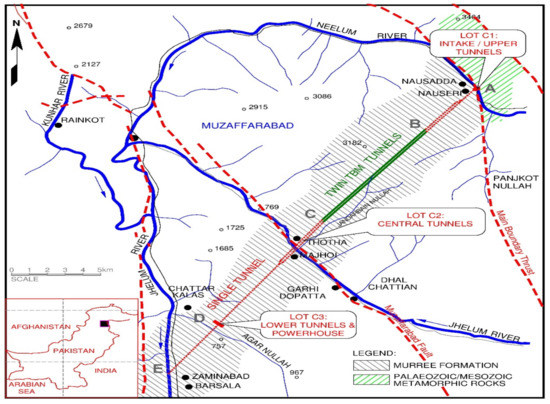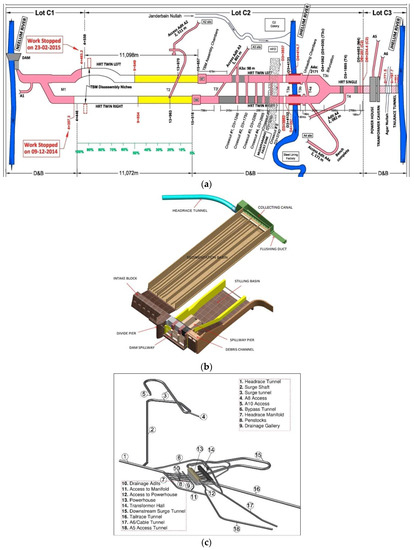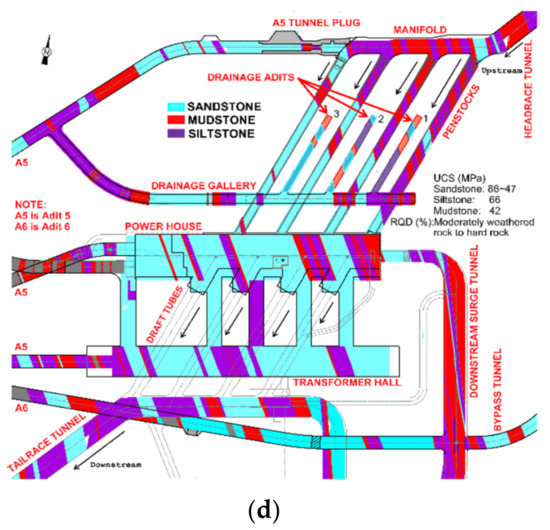During underground construction, the behavior of the ground is influenced by characteristics of the rock mass with situ stresses and ground water, cross section of the excavation area, excavation method, and the rate of excavation. These fundamental features are considered to ensure the support and stability of underground excavations and achieve long-term successful operation. However, the ground composition of the Himalayas hinders tunnel excavation, especially in case of mechanized tunneling; this causes time and cost overruns. This study has reviewed the recently completed Neelum–Jhelum Hydroelectric Project; the project complexities, geological environments involving significant overburden and tectonic stresses, and effects of the excavation method on tunnel stability were analyzed.
- Neelum–Jhelum Hydroelectric Project
1. Introduction
In order to overcome the electricity crisis in Pakistan, the northern part of the country has been considered a suitable location for implementing hydroelectric power projects in the deep dissected valleys, with the aim of achieving large amounts of storage and high water heads for power generation. Underground excavation is a key aspect of almost every hydropower project in this area of the country, owing to the presence of valleys and mountains. However, constructing these hydroelectric power projects in the area is challenging, both technically and financially. From a technical perspective, the Himalaya is a young mountain range; it is tectonically active, and the rocks are reasonably incompetent and affected by a number of faults, folds, and thrusts of varying extents. Moreover, several locations in this area also feature with subsurface water. Geological factors, such as the properties of the rock mass, virgin stress settings, and inflow of groundwater through discontinuities, affect the stability of underground excavations and they are called ground composition parameters [1][2][3]. In the Himalayas, ground composition parameter-related problems, such as rock bursting, squeezing, and groundwater inflow, are encountered in nearly all deep excavation projects [4]. Here, in situ stresses are comparatively unbalanced, as they are geologically age dependent, to a large extent. As it is the youngest mountain chain worldwide, it is relatively more challenging to perform tunneling in this area using tunnel boring machines (TBMs) [5].
Along with ground composition, project-related features, which include the shape and size of the tunnel and the method and rate of excavation, are also important in the successful completion of projects [3]. The underground excavation method (mechanical or drilling and blasting) is responsible for the stress–strain behavior at the excavation face, and this behavior depends on the cross-section of the excavation area, along with the quality of the rock mass [6]. Ground composition parameters are responsible for the risk that is associated with tunneling; therefore, they directly affect excavation-related features of the project [7]. Although mechanical excavation is advantageous in low-stress environments, it is destructive in high-stress environments, as compared to the conventional drill and blast (D&B) method [8][9].
The Neelum–Jhelum Hydroelectric Project (NJHEP) is a major underground project, constructed in the complex geological environment of the Himalayas, in Pakistan. Almost a decade was required to complete the construction of this project, which can produce 969 MW of electricity. The initial design for underground excavation considered the use of the conventional method; however, during construction, for a significant length of the tunnel excavation, the TBM-based method was used for reducing project construction time. This design altered the project-related features that are associated with challenging ground composition. Underground construction was delayed at different periods, owing to extreme ground compositions, which presented significant challenges during tunneling. The changes in design, quality, and scope of the work resulted in a considerable increase in the construction time and cost [10]. During and after the completion of this project, significant research efforts were devoted toward evaluating the critical role of rock mechanics in the design and construction of underground structures. This study focuses on reviewing the effect of ground compositions and project-related features on tunnel stability that is based on previous research associated with this project.
2. Project Description
2.1. General Description
The NJHEP, undertaken by the Water and Power Development Authority, Pakistan, is a recent hydroelectric project located in northeastern Pakistan, in the Muzaffarabad district of Kashmir, as shown in Figure 1. Its construction commenced in late 2008, and the first turbine generated power in April 2018. The designed capacity of the project is 969 MW of electric power generated from 283 m3/s of water; this water is diverted from the Neelum river to the Jhelum river through tunnels, creating a gross hydraulic head of 420 m. The main structures in this project include a diversion dam and an intake system, headrace tunnels, an underground powerhouse complex, and a tailrace tunnel. Underground excavation work accounted for more than 80% of the construction that was involved in the project.

Figure 1. Project location.
The 28.6-km-long headrace tunnels comprise single (34%) and twin (66%) circular and horseshoe-shaped tunnels. The tunnels are oriented along the northeast–southwest direction, and the cross-section of the excavation spans ranges of 10.7–11.8 m and 7.75–8.53 m for the single and twin headrace tunnels, respectively. A single tunnel with the modified horseshoe-shaped cross-sectional area and a hydraulic span of 9.6 m is split into twin headrace tunnels (0.9 km from the intake portal). Thereafter, these twin headrace tunnels, with a hydraulic diameter of 6.8 m, rejoin at approximately 20.5 km downstream from the intake portal. After converging into a single tunnel, the headrace tunnel continues for a distance of 8 km downstream and it reaches the underground power station comprising four generating units. After generating 969 MW of electric power, a 3.5-km tailrace tunnel discharges the water into the Jhelum river. The project also consists of 10 access adits, with a total length of approximately 11 km.
Commonly unreinforced concrete lining (Type A) with a minimum thickness of 350 mm was used in this project. Type B linings also have the same minimum thickness; however, they are singly reinforced. In the single tunnel, heavily reinforced Type C structural lining with a thickness of 600 mm is used. The same type of lining, with a thickness of 500 mm, was used in the twin headrace tunnels. Approximately 44% of the length of the headrace tunnels is lined with the Type A concrete liner, whereas 42% (the section mined using the TBM-based method) is lined with shotcrete.
For construction, management, and documentation purposes, the project was divided into three sectors or sites, referred to as Lot C1, Lot C2, and Lot C3 (Figure 1 and Figure 2a). Table 1 lists details of the underground excavation in the project for all three lots.


Figure 2.
(
a
) Project layout showing all three construction sites, (
b
) dam site, (
c
) three-dimensional (3D) details of powerhouse, and (
d
) powerhouse geology and underground construction.
Table 1. Underground excavation details of three lots in the project.
| Lot | Excavation | Length (m) | Excavation Size (m) (Cross-Sectional Area (m2)) | Shape | Remarks Any |
|---|---|---|---|---|---|
| C1 | Diversion tunnel | 493 | 10.5 × 9.5 (77) | U-shaped | D&B * |
| Adit A1 | 390 | 7 × 8 (51) | U-shaped | D&B | |
| Single headrace tunnel | 874 | 9.7–11.7 (77–113) | Horse-shoe shaped | D&B with finished dia of 9.6 m | |
| Twin headrace tunnel | 4797 + 4400 (R + L) | 7.9 (51) | Horse-shoe shaped | D&B with finished dia 6.8 m | |
| C2 | Twin headrace tunnel | 9895 + 10,434 (R + L) | 8.53 (57) | Circular | TBM ** with finished dia 7.6–7.9 m |
| Twin headrace tunnel | 4950 + 4837 (R + L) | 7.9–8.5 (51–60) | Horse-shoe shaped | D&B with finished dia 6.8 m | |
| Single headrace tunnel | 4433 | 10.7–11 (94–100) | Horse-shoe shaped | D&B with finished dia 6 m | |
| Adit A2 | 2475 | 7 × 8 (51) | U-shaped | D&B | |
| Adit A3 | 1890 | 7 × 8 (51) | U-shaped | D&B | |
| Adit A4 | 2090 | 7 × 8 (51) | U-shaped | D&B | |
| Adit A4a | 2175 | 9 × 9.3 (100) | Horse-shoe shaped | D&B | |
| TBM assembly chambers | L = 100 m R = 60 m |
20 × 15 | Horse-shoe shaped | D&B | |
| C3 | Headrace tunnel | 3622 | 10.7–11.7 (94–113) | Horse-shoe shaped | D&B with finished dia 6 m |
| Tailrace tunnel | 3550 | 10.7–11.7 (94–113) | Horse-shoe shaped | D&B with finished dia 6 m | |
| Powerhouse | 130 | 23 × 50 (varies) | U-shaped | D&B | |
| Transformer cavern | 170 | 16 × 20 | U-shaped | D&B | |
| Adit A5 | 660 | 7 × 8 (51) | U-shaped | D&B | |
| Adit A6 (cable tunnel) | 680 | 7 × 8 (51) | U-shaped | D&B | |
| Adit A7 | 370 | 5 × 7.5 | U-shaped | D&B | |
| Adit A8 | 62 | 6 × 7 | U-shaped | D&B | |
| Adit A10 | 50 | varies | Varies | D&B | |
| Surge shaft and surge tunnel | 350 (shaft), 743 (HST) | 11, 10.7–11.7 | Circular shaft and horse-shoe-shaped tunnel | D&B with finished dia 9.6 m | |
| Drainage gallery and drainage adits | 212, 60 | 5 × 5 (DG), 3 × 3 (DA) | U-shaped | D&B | |
| Penstocks and draft tubes | 118 (P), 98 (D) | 6.6 × 6, 6.6 x 8 | Varies | D&B | |
| Tailrace manifold and tailrace surge tunnel | 880 | 11.7 (113) | Horse-shoe shaped (varies) | D&B | |
| Bypass tunnel | 300 | 7 × 8 (51) | U-shaped | D&B |
* (D&B = Drill & Blast method for excavation), ** (TBM = Tunnel Boring Machine for excavation).
Lot C2 of the project includes the excavation of approximately 43 km of tunnels, including the access adits. Below the Jhelum river (170–180 m overburden), the 732-m-long twin-tunnel section is called the Jhelum crossing. Steel lining supported this specific length instead of concrete, owing to inappropriate confinement [11]. This section only accounts for 3% of the total tunnel length. The headrace tunnel features a steep slope of 10.8% in this stretch, which is upstream of the Jhelum crossing area.
References
- Panthi, K.K. Evaluation of rock bursting phenomena in a tunnel in the Himalayas. Bull. Eng. Geol. Environ. 2012, 71, 761–769.
- Palmstrom, A.; Stille, H. Ground behaviour and rock engineering tools for underground excavations. Tunn. Undergr. Space Technol. 2007, 22, 363–376.
- Stille, H.; Palmström, A. Ground behaviour and rock mass composition in underground excavations. Tunn. Undergr. Space Technol. 2008, 23, 46–64.
- Sharma, H.; Tiwari, A. Tunnelling in the Himalayan Region: Geological problems and solutions. Int. Water Power Dam Constr. 2012, 64, 14–19.
- Carter, T. Himalayan ground conditions challenge innovation for successful TBM Tunnelling. In Proceedings of the Invited Paper in Proc. Hydrovision India 2011 Conference, SESSION 5c:(Risk Management in Tunnelling); Golder Associates: Toronto, ON, Canada; 2011; p. 20.
- Celada, B.; Tardáguila, I.; Varona, P.; Rodríguez, A.; Bieniawski, Z. Innovating tunnel design by an improved experience-based RMR system. In Proceedings of the World Tunnel Congress, Foz do Iguaçu, Brazil, 9–15 May 2014; p. 9.
- Verman, M.; Carter, T.; Babendererde, L. TBM vs D&B—A difficult choice in mountain terrain–some geotechnical guidelines. In 12th ISRM Congress; International Society for Rock Mechanics: Lisbon, Portugal, 2011.
- Rehman, H.; Ali, W.; Naji, A.; Kim, J.-J.; Abdullah, R.; Yoo, H.-K. Review of rock-mass rating and tunneling quality index systems for tunnel design: Development, refinement, application and limitation. Appl. Sci. 2018, 8, 1250.
- Mazaira, A.; Konicek, P. Intense rockburst impacts in deep underground construction and their prevention. Can. Geotech. J. 2015, 52, 1426–1439.
- Hanif, H.; Khurshid, M.B.; Lindhard, S.M.; Aslam, Z. Impact of variation orders on time and cost in mega hydropower projects of Pakistan. J. Constr. Dev. Ctries. 2016, 21, 37.
- Kizilbash, M.H.; Dickson, P.A.; Jaffery, N.A. Neelum Jhelum hydroelectric project: Pre-excavation grouting in twin headrace tunnels. Grouting 2017, 2017, 238–248.
